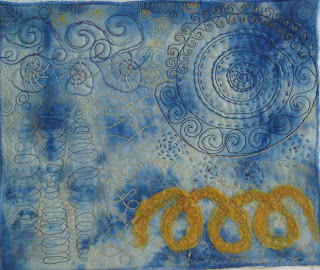Here is a collection of twisted, knotted, plaited, wrapped and stitched cords. I have used fancy yarns, thorn stripps of fabrics, chenille, wool, silk yarns, organza stripps and raffia, gift ribbons, painted tywek-stripps.
Even so I made cords with three krocket- cords, which I put together with my enbellisher. At last you can see my knotted, plaited and wrapped cords on picture 23 using the following knots:
-barrel knots, doubble buttonhole knots, macrame knots, ordinary knots, repeat half knots, weaving with 4 cord and one threaded beads, yellow turks head knot.
This picture shows different tassels. I have used different materials, hand- as well as machine made tassels. The materials are the same a used in the chapter 5.
Module 3, chapter 7
In this chapture I have made buttons.
Picture 24 shows the wrapped shapes used big and small shapes from cardboard.
Picture 25 shows dorset buttons. I have used thorned stripps, fancy yarns, beads and stitching yarns.
Picture 26 shows toggles, beads made from metable materials- viscose felt, nylon fabrics and tyvek. The wrapped layers are painted and zapped with hot gun. I have also used a hot soldering iron to make patterns on the toggles.
In this chapter I have to make a bead-sampler. This sampler I want to use as a cover for a book or a box. The background fabric is kunin felt. With the embellisher I stitched down different blue silk material. I have done this in my coulor scheme. I used different methods of application to sew the beads and the sequins. Also two bundles of beaded fringes are stitched. The three sequences on the right side are under a transparent sheet of organza. Spaces between are stitched by hand.
Module 3, chapter 9, picture 28, 29, 30, 31 and 32
The first picture is my starting point for the design development of this movement..This picture I have painted with acrylic paint at the beginning of this module.
I cut this picture in sections and turned the pieces in the same way as in module two. You can see the pencil-lines before cutting.
These pictures show more ideas of spiralic designs. All these ideas are done with paper.
The next picture is a design which I have layed with selfmade cords and buttons. background is an overdyed silk.
The next four pictures show the stepps to the resolved sampler.
Layer 1: My overdyes silk
Layer 2: Done with watersoluble, snipped fragments of blue organza. This layer was than embellished on my first layer and sewed down with free machine motion.
Layer 3: Consists of machine-stitched organza cords. The hole piece was than stitched by hand and I added toggles.
.





















































